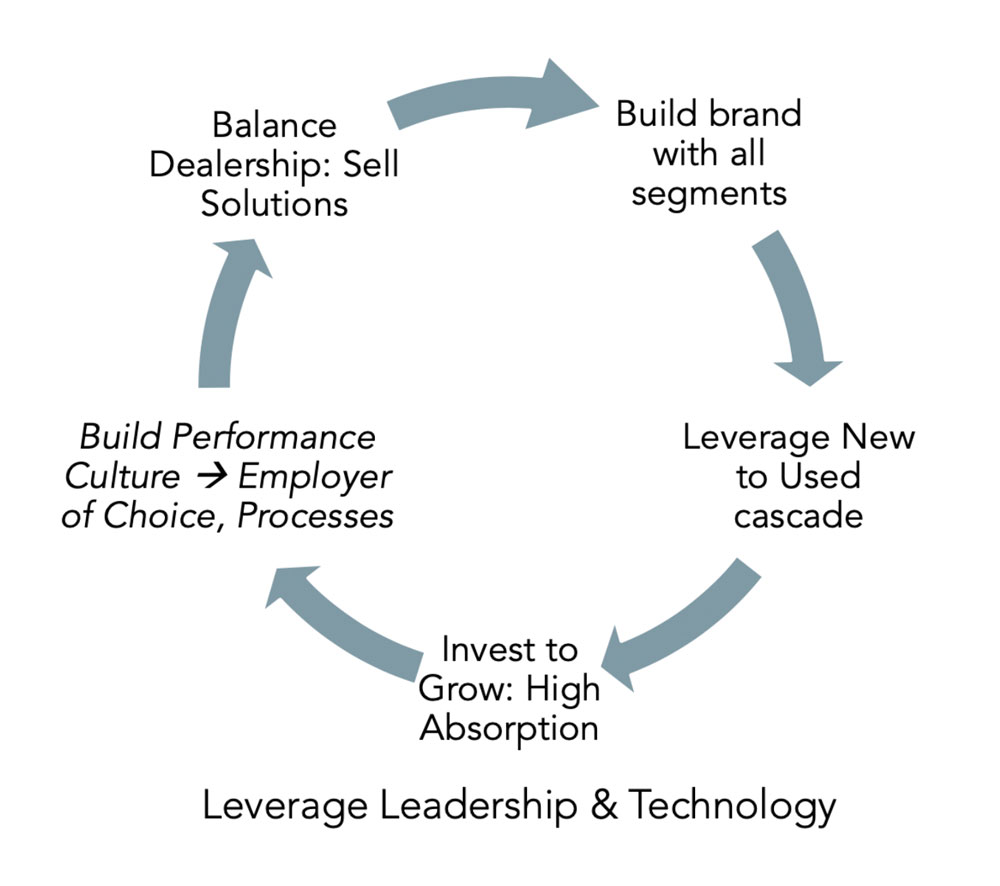How your entire dealership hears and serves the customer is at the core of the 4th spoke of the flywheel. Dealerships that are built with balance and whose people are trusted to deliver and serve consistently will retain those customers and attract more new customers. The new and repeat customers give a huge boost in momentum to a dealership.
A dealership is balanced when:
- All departments are considered to be “sales” departments not just the wholegoods sales department. Solutions selling starts when everyone in the dealership, no matter the department, contributes to working together to satisfy the customer’s needs.
- Everyone is in service — all are dedicated and deliver daily to keep machines running well and customers happy.
- Everyone knows how success is defined — all know the key performance indicators or high-performance benchmarks.
- These include financial measures as well as metrics for customer satisfaction and repeat customers.
- The processes and people are oriented to a culture of performance.
Solutions Selling
Solutions selling starts with specifying and delivering a machine capable to do what the customer wants. This means the right size with the appropriate attachments and options.
Solutions extend beyond the machine specifications. Examples of other needs and wants of the customer that fulfill a need are:
- Orientation at machine delivery with training on how the machine is designed to work and includes an explanation of your policies and key contacts for service and support.
- Extended warranty — sold at time of the sale and which could include new and used equipment.
- Services that help fix before failure. Examples include maintenance and repair contracts; lube and fuel services; and telematic and fleet monitoring.
- Seasonal operator refresher training.
- Agronomic services.
Everyone Sells, Everyone Serves
Because a solutions selling approach creates value from the entire dealership and earns the trust of customers, the use and meaning of words is important.
When we say the sales department or salesperson, does that mean that only those people sell? Of course not. Every interaction between a dealership employee and a customer or prospect creates the opportunity to sell.
We could reinforce this idea by how we name the departments. Instead of sales, service and parts departments, what about:
- Wholegoods Sales or Machine Sales
- Service Sales
- Parts Sales
Or shortened to wholegoods/machines, service and parts.
For the administration, accounts receivable and finance areas, could they be called Customer Support?
Just as everyone sells and enhances the entire dealership, it isn’t only the service department that provides service.
Think of all the people who interact with customers or prospect and how they can serve your customers.
- Initial contact with customers or prospects — a receptionist or live chat person on your website who responds efficiently and quickly to an urgent request is in service.
- A parts counterperson who goes the extra mile to research a part, find an alternative or even rob a part off a machine is in service.
- A sales rep who notes a leaking seal, sets up a machine inspection or who delivers parts is in service.
The opposite of this approach is department silos. The silo mentality is driven in large part because of consultants like me promoting KPIs and department benchmarks.
As the leader, you must maintain accountability for department results while encouraging and demonstrating the balanced dealership and solutions selling practices. This could mean:
- Whole dealership incentives for department managers.
- Encouraging and praising collaboration between departments.
- Reward the team for solving a customer’s problem.
- Using words (see above) and examples that show that everyone sells and everyone is in service.
A Listening Organization
Finally, the best dealerships have built a culture that listens well — both with customers and also to colleagues within the dealership. When people take the time to listen hard, they are more likely to really understand the customer’s needs and then to craft the best solution.
To build on this spoke, remember it’s not a destination but a journey. Customers’ needs for solutions constantly change and evolve. So should your dealership.







